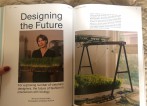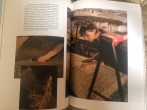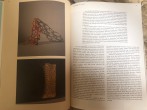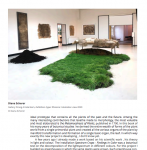

#1


#2
ANTENNAE-ISSUE-52_Diana-Scherer_compressed
Interview by Dawn Sanders
Embarking on a more artistic endeavour and fascinated by the intelligence and behaviour of plant roots, Diana Scherer has explored the material ability of plant roots at the seedling stage to create an unprecedented textile- like material, Interwoven. Through a self-developed technique, aided by digital fabricated templates which guides the growth of plant roots (patent pending), the artist directs plant roots into geometric patterns found in nature, like honey- comb or microscopic cell structures. Scherer’s work illustrates that roots are not only productive means but also intelligent agents that respond to and adapt actively and dynamically to their environment.
Dawn Sanders: When did you start working with plants and why?
Diana Scherer: Ten years ago I started working with plants. I was interested in the relationship of man versus his natural environment and his desire to control nature. First I worked with the plant parts that grow above ground and then slowly went down to the bottom. I became captivated by the root system, with its hidden, underground processes. It’s not always easy to explain a fascination and where it comes from. Often this are unconscious processes. But in this case I know that my interest for crops started with my grandparents. They were farm- ers and during the visits to the farm I explored in a naturally way the life of plants. In this case mainly food plants such as grain. In my current project I also work a lot with grain such as oats or corn. My grandmother was also extremely handy with textiles. I consider her, Walburga Scherer, to be the basis of Exercises in Rootsystem Domestication.
DSa: In your work you make public the parts of plants that are often unseen- the roots. Has working in such close physical contact with the roots of plants impacted on your understanding of plants and if so, in what ways?
DSh: From my collaboration with the root system I learned about underground biodiversity. For example some plants like to grow close to each other and sup- port each other below ground and other species fight their living space and don’t tolerate other species next to them. I have studied their appearance and their aesthetic quality and on a certain moment I started to approach the root system as if it were yarn. For example, the refined, white root structure of grass reminds me of silk and the powerful, yellowish strands of the daisy I compare to wool. I have learned that an enormous communication takes place underground. The rhizosphere forms a very dynamic environment in which the plant roots and many organisms are located. Plants communicate with each other and collabo- rate with other organisms for example fungi and bacteria. For example plants are able to warn each other via the subterranean network over kilometres of danger or use it to feed each other and eliminate or support weaker plants. Roots are incredibly strong. In their search for food and space they fight for every space they can find. I use this natural strength to weave my textiles of plant rootsDSa: Can you describe how your work Exercises in Root System Domestication first began and what the key factors were in deciding to work this way?
DSh: In the beginning I worked with nature in different ways. For example I started to collect and photograph plants. Also I found it especially exciting to bring nature and its phenomena into my studio. At one point I had a whole collection of molehills in my studio. The rootbound image, a plant that had grown in a pot for a very long period, re- mained for a long time in my mind and on a photograph on my studio wall. At one point I started to work with this image and filled my vase collection, which I collect- ed for many years, with soil and seeds. I nurtured the plants for three month and then broke the vases. The root system has taken over the shapes. I photographed the plant with the root ball in the shape of a vase. It all happened very intuitively but in this period I learned a lot about roots. After this project Nurture Studies 2012 (book published by van Zoetendaal publishers) I carried on exploring this burried matter.
After a period of research I had the idea to weave the root system. For this I contacted science in 2016. I started to study the below ground processes in cooper- ation with experts at Radboud University Nijmegen. In this period I developed the new technique Interwoven to control the growth of plant roots. With Interwoven the natural network of the system turns into a textile. During the growing process the roots assimilate to underground templates and weaves the material itself.
DSa: How has working across disciplines impacted upon the ways you think about, and construct your own artistic identity, in work such as the new exhibition Hyper Rhizome?
DSh: The collaboration has inspired me ta lot. In particular, I contacted biologists from the Radboud University Nijmegen to expand my botanical knowledge. It was a very practical approach. Mainly I wanted to know more about the world of roots. Radboud University was known for its specialists and they had just set up an entire root lab. This collaboration satisfied my curiosity to a certain extent. In addition to the research, I have seen a lot that it has inspired me to new ideas. My role as an artist has not changed except that I have become aware that my work can be a linkbetween science and society as kind of translator.
I also found it interesting to see that my open-mindedness and unscientific approach can help me to take steps that science has long regarded as impossible and excluded in advance. For example, when I told them that I wanted to weave the root system underground they had little faith in it but because my enthusiasm and my earlier work convinced them I was allowed to join them in the greenhouses.
DSa: I am interested in your partnership with biologists and engineers, especially as a cross-disciplinary act, even the name of the lab suggests a conscious move to create epistemic border-crossings. Can you describe how this space provokes, and/or facilitates new relationships around art and sci- ence? Has it changed your practice as an artist?
I contacted the Material Experience Lab of the TU Delft because of their research in ‘Growing Material’. Two Master students graduated last year on my project Interwoven. (master of science) with the assignment to develop the material more solid and into 3d.
DSh: In addition to my autonomous work, I also started an innovative material re- search. My goal in the coming period is to develop the bio-manufactured material from plant roots into a sustainable and applicable material.
That was a new experience for me as an artist. I was curious about the scientific approach in addition to my intuitive research. A textile of plant roots is a new mate- rial and has never been used for a material application. A textile of plantroots is a new material and has never been used for a material application. I see it as a challenge to develop the material to such an extent that it can be applied, for ex- ample in the textile industry.
At my exhibition Hyper Rhizome I show a selection of our experiments. It hasn’t changed my practise as an artist. I can easily separate my autonomic work from these excursions to science. They are learning moments for me and often they are helpful. I experience it as inspiring and it supports my autonomous practice. My visual back- ground gives me the opportunity to approach the world of science in an open-minded way and make it accessible to the viewer through my work.
DSa: In the invite to your new exhibition, Hyper Rhizome, the work of Charles Darwin is mentioned, especially his book The Power of Movement in Plants. Does Darwin the bota- nist influence your thinking about plants? And if so, are there any particular aspects of his work that resonate with your current entanglements with plant-life?
DSh: When I became interested in the root system I came across the experiments of Charles and Francis Darwin. From the Darwins I learned that plants did not belong where they were classified by Aristotle: at the bottom of the hierarchy of living nature, just a decor for man and animal. Their research helped me to better understand my own root observations. They experimented a lot with the dynamics of the roots. They described the root apex as a ‘brain- like’ organ. I found that exciting. The book describes their botanical experiments with the movements of various plant parts and development stages of the plant root. I found that very helpful. My approach is intuitive and I work with my imagination, but I find the confirmation from the scientific world a pleasant addition. In the book The Pow- er of Movements of Plants the ‘intelligence’ of plants is seriously considered and tested the first time. In my work Exercises in Rootsystem Domestication I use this dynamic/intel- ligence. They describe how roots do not passively grow down, but move and observe. A root navigates, knows what’s up and down, observes gravity and localizes moisture and chemicals.
For the project I developed a technique to guide the growth of the plant root. With the help of underground templates, I control the root system. During the growing pro- cess, the roots conform to underground templates and the textile weaves or braids itself. In this project I apply the strength of nature to weave a textile.
DSa: The Netherlands is known for its horticultural production: fields of tulips and ranges of vegetable growing glasshouses. This industrial approach creates a particular aesthetic of, and relationship to, the plant-world against which your productions seem to be more consciously associated with characteristics of the growth entangled with plants, and yet, the titles of your work acknowledge your domesticating role. Do you feel a tension here? Is it a conscious commentary on the current relationship between much of the urban human population and the plant community?
DSh: My projects are certainly a response on the relationship of man versus his natu- ral environment. The point of departure is the ambiguous tendency of man to cherish nature, while simultaneously recklessly manipulating it.
I was interested in the beauty, necessity and at the same time the destructive side of the manipulation. With Interwoven- Exercises in Rootsystem Domestication I force nature to go my way and use its strength to create the work. I try to approache this subject in a poetic way. I am aware of the cruel part of the project.


#1


#1
Tracy Metz on Hyper Rhizome at Droog Gallery Amsterdam
https://www.tracymetz.nl/2020/02/05/diana-scherer-maakt-kunstwerken-van-levend-textiel/
Exhibition 18 February – 15 March
Weaving roots at the interface between art, fashion and science
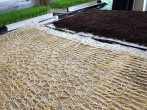

#1


#2


#3
Artist Teaches Roots To Grow In Beautiful, Alien Patterns
THE HUMAN RACE has a long history of bending nature to its will. The results of this relationship can be devastating—but they can also be strikingly beautiful, as German artist Diana Scherer skillfully proves with her low-relief sculptures made from plant roots. Scherer grows these works of art by planting oat and wheat seeds in soil, and then carefully, meticulously, warping the growth pattern. She prefers to train her roots into geometric patterns found in nature, like honeycomb structures, or foliate designs reminiscent of Middle Eastern arabesques.
But even with that botanical theme, applied to a botanical substance, Scherer’s pieces look distinctly alien—like the plant equivalent of women who’ve trained their waists with corsets, or feet with foot binding. “I think that people, they cherish nature, but on the other hand they are really quite cruel with nature,” Scherer says. “Like the gardener is telling us he loves nature, but the garden has to look like what he wants it to in his mind. He has to crop and prune and use poison.” Scherer makes no claims to a nobler process. Her artistic impulse, she says, is to control the roots in her pieces. “The roots that I domesticate, they have to do what I tell them.”
Scherer started contemplating what she calls root system domestication in 2012, during work on a series called “Nurture Studies.” She created those pieces by potting flowers in vases, allowing the soil and roots to congeal in place, and then breaking the vases. The root patterns were frozen in place and totally exposed, and Scherer says she became fascinated by the vast differences in growth patterns, colors, textures, and thicknesses. It reminded her of yarn, and, because she’s an artist, she immediately wondered if she could weave roots underground.
Scherer won’t say much about the technique she’s developed in the years since, other than it involves a “template,” which functions like a mold. Since late 2014 she’s worked with biologists and ecologists at Radboud University in Nijmegen, in The Netherlands, learning more about which types of roots grow fast and train easily (oats and wheats) and which ones grow slowly and with less structural conviction (daisies). This year, Scherer won the New Material Award from Het Nieuwe Instituut for the arts, in Rotterdam, for her textile-like pieces. With the help of the scientists at Radboud, she’s working on strengthening the designs even further and researching its market potential (hence the secrecy.)
For now, Scherer is in a stage of rapid experimentation. By adjusting the density of seeds or planting a new strain of grass, she can produce wildly different textures. The work is, by definition ephemeral—Scherer says she gets each piece for about two weeks before it starts to dehydrate and shrivel. But even with that lifespan, her bounty is significant. “I’m growing out of my studio,” Scherer says. Which feels kind of poetic. Even when you’re taming nature, it finds ways to take over.
https://www.wired.com/2016/12/artist-teaches-roots-grow-beautiful-alien-patterns/
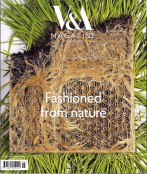

#1


#2
Interview with Caroline Roux about growing a dress from plant roots, which features in the Victoria & Albert Museum ‘Fashionioned from Nature’ exhibition.
The work of German-born artist Diana Scherer explores what she calls “the dynamics of belowground plant parts.” She uses plant roots themselves as a medium for creating patterns and networks, the purpose of which is to suggest overlaps between human technological activity and the embodied “intelligence” of living botanical matter. “This buried matter is still a wondrous land,” she writes. The results are incredible. They feature roots woven like carpets or textiles, imitating Gothic ornament with floral patterns and computational arabesques underground. Compare Scherer’s work, for example, to traditional Gothic plant ornament—that is, geometric shapes meant to imitate the movements and behaviors of plants—but here actually achieved with plants themselves. Scherer calls this “root system domestication,” where, on the flipside of an otherwise perfectly “natural” landscape, such as an expanse of lawn grass, wonderfully artificial, technical patterns can be achieved. The idea that we could grow biological circuits and living rootkits is incredible, as if, someday, electronic design and gardening will—wonderfully and surreally—converge. You simply step into your backyard, exhume some root matter as if harvesting potatoes, and whole new circuits and electrical networks are yours to install elsewhere. After all, the soil is already alive with electricity, and plants are, in effect, computer networks in waiting. Scherer’s work simply takes those observations to their next logical step, you might argue, using plants themselves as an intelligent form-finding technology with implications for the organic hardware of tomorrow.

